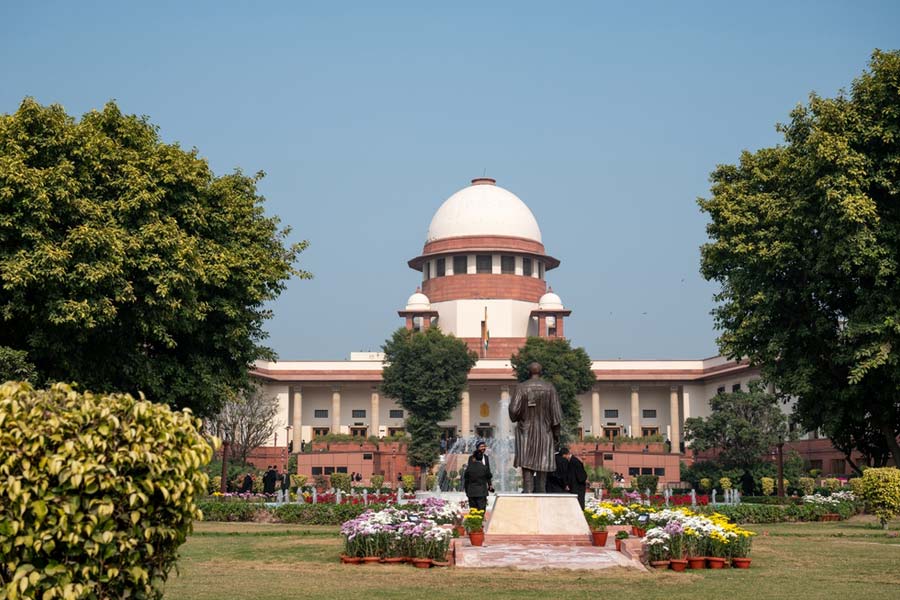 |
| Pictures by Tamaghna Banerjee |
Calcutta, March 30: Stephen Court’s locked collapsible grille on the terrace that cut off the escape route of at least 17 victims has brought to the fore a question occasionally debated in housing complexes but rarely settled with unanimity.
Whose roof is it?
The 17 who were trapped and charred to death did not have the keys that would have unlocked the grille and possibly led them to survival.
It does not appear that more than two sets of keys were in existence — in a building that housed 130 commercial establishments and 35 residences.
A sale deed in possession of The Telegraph makes it clear the right to the terrace, shared by the four blocks, was held by Stephen Court Ltd, which had the sanction to build one floor on the sixth-floor rooftop.
“The roof and terrace… shall remain the property of the Confirming Party (Stephen Court Limited)… with absolute right to sell, transfer, let out, or dispose of the same,” reads the deed.
“The right to the roof was with the company on the ground that it had the right to build a seventh floor,” a representative of Stephen Court Ltd said.
Till last year, the promoters or owners of a building enjoyed the right to control access to the roof, provided they had sanction to build more floors.
Not any more.
Under the CMC’s building rules of 2009, any new construction or reconstruction in an old building must allow all occupants easy passage to the top. Section 117 (IV) of the rulebook states that “every terrace or topmost storey of any building” shall have “a common access”.
The stairs must lead to the terrace and everyone must enjoy equal access. So, if the door to the terrace is kept locked, every flat or unit has the right to demand a key.
What about buildings whose plans were sanctioned before 2009? Can residents demand a key to the roof? “No such challenge has reached the courts yet,” said a CMC official.
However, in the light of the Stephen Court tragedy, pressure is expected to mount on housing societies and builders to share duplicates of the terrace key with all residents.
The key to the Stephen Court terrace was with the arrested caretaker, Tarun Bagaria, a sixth-floor resident, said some residents.
The residents added that their appeals for duplicate keys were turned down because the overhead telecom towers needed to be safeguarded.
But the Stephen Court representative said one set of keys was with the caretaker and another with members of the building managing committee. “The grille was not kept locked to protect the mobile towers. There was nothing valuable on the roof. The roof of any such building becomes a den of criminal activities and it was kept locked to prevent that,” he said.
What if the occupants of Block II of Stephen Court had the keys of the grille on March 23?
“Some of the victims could have reached the open terrace and not died of suffocation,” said Gopal Bhattacharya, the director of fire services.
Many builders in the city continue to retain the right — and keys — to the roof, either to build an extra floor or to milk the rooftop mobile towers.
“Depending on a provision in the original agreement, the builder can retain the right to vertical expansion in future if the civic body increases the FAR (floor-area ratio),” said Pradeep Sureka, the president of the state chapter of Credai, the umbrella body of realtors. “But the right to use the roof remains with all apartment owners.”
In modern housing complexes, the flat owners must have roof rights and access, added Jitendra Khaitan of Pioneer Properties.
Nero’s fall
 |
If the delay in fighting the Stephen Court fire drew inevitable comparisons to Nero’s cursed legend, the emperor’s palace complex in Rome suffered a ceiling collapse on Tuesday.
Nero, yoked to the charge of fiddling while Rome burned, built his fabled palace, now around 2,000 years old, as a party villa rather than a residence.
The Golden Palace or Domus Aurea lies on a hill overlooking the Colosseum. An official said the collapse did not touch the main part of the palace but affected a gallery subsequently built at the site by Emperor Hadrian.
Workers were carrying out repairs when a part of the roof collapsed, causing a section of the garden above it to fall into the palace over an area of some 100sqm (AP picture above). No injuries were reported.
Nero did not enjoy the palace for too long. It was completed in AD68, the same year the emperor committed suicide. The complex lay under tonnes of dirt in the bowels of a hill for centuries, before coming to light 500 years ago.










